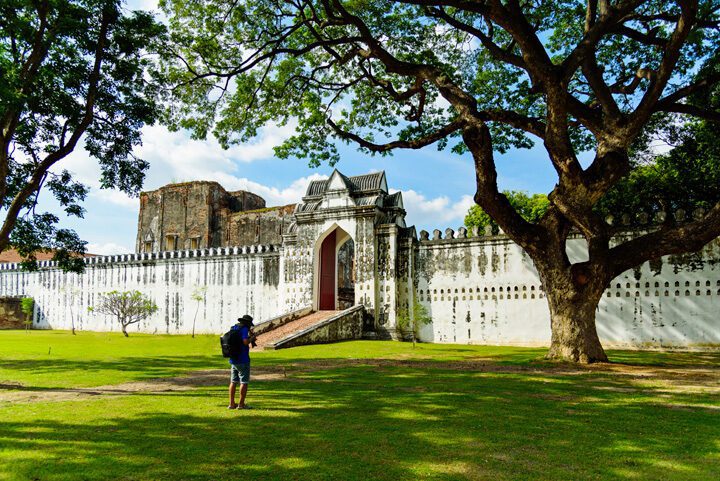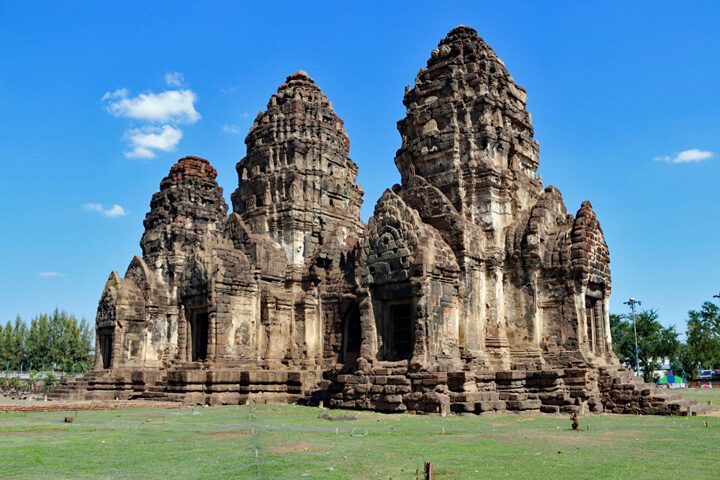Lopburi, a rich history and cheeky monkeys (video)

Dusit Sawan Thanya Maha Prasat Throne Hall at King Narai's Palace
Lopburi (ลพบุรี), also called Lop Buri or Lob Buri, is an interesting city with a rich history about a three-hour drive north of Bangkok. It is one of the oldest cities in the world Thailand and for that reason alone it is worth a visit.
The city was founded in 1350. Even Marco Polo described Lopburi in his travelogues, the city was then called Lavo.
King Narai the Great
Lopburi is believed to have been founded around the 6th century by the Mon, an ethnic group from Southeast Asia. In the 10th century, Lopburi became a part of the Khmer Empire, under the rule of King Suryavarman I. During this period, many beautiful Khmer temple and buildings were built in the city, such as Prang Sam Yot shrine and Wat Phra Si Mahathat. Many of these historical structures can still be seen in Lopburi.
In the 13th century, Lopburi came under the influence of the emerging Thai kingdom of Sukhothai. Later, in the 14th century, Lopburi became an important center of the Ayutthaya Kingdom, covering most of present-day Thailand. King Narai the Great, one of the most prominent rulers of Ayutthaya, made Lopburi his second capital in the 17th century and built many palaces and forts there. King Narai was known for his diplomatic contacts with European countries, and Lopburi became a cosmopolitan center with visitors and traders from different parts of the world.
After the death of King Narai in 1688, Lopburi lost significance and fell into disrepair. Many of the buildings were abandoned and overgrown by the jungle. In the 19th century, under the reign of King Mongkut (Rama IV) and King Chulalongkorn (Rama V), Lopburi was rebuilt and restored. King Narai's palace was turned into a museum, and many of the ancient temples were restored.

Phra prang Sam Yot (three holy prangs) in Lopburi province, Thailand. The monument was likely founded in the late 12th or early 13th century.
macaque
Today, Lopburi is a scenic and historic town popular with tourists interested in Thailand's history. Visitors can stroll through the ancient ruins and palaces, and visit the many temples and shrines that date from different periods of Thai history.
Today, the city is best known for its hundreds macaque (Macaca fascicularis ) that roam freely in the middle of the city. Especially around the Khmer temple, Prang Sam Yot and the Khmer sanctuary, Sarn Phra Karn, you see the monkeys in large numbers. Prang Sam Yot is originally a Hindu shrine. The structure has three prangs, representing Brahma, Vishnu and Shiva (the Hindu trinity). It was later recognized as a Buddhist shrine.
De apes are fed by the locals, especially during the Monkey Festival in November. The hundreds of monkeys are not afraid of humans and are almost a nuisance. They are left alone by the population because they are said to bring 'luck'.
In the video below you get a nice impression of the cheeky monkeys.
Video: Lopburi, history and monkeys
Watch the video here:


Not only the monkeys are cheeky, also the sellers of the food for the monkeys, when I passed they said to me, Hello monkey.
Still laughing about that my wife and I.